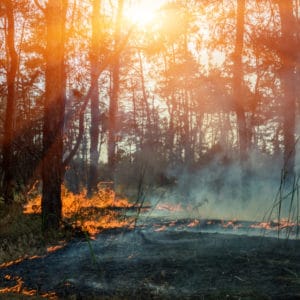Another Smoky Summer? Protecting Your Assets During Wildfire Season


Washington state continues to see an increase in the frequency and severity of wildland fires.
Wildfires are now common in Washington starting as early as April and extending through mid-October. Many firefighters were surprised when over 50 wildfires broke out this year in March in typically wet western Washington. Although many of the fires are on public land, our state is experiencing more fires that also burn private property. More land and homeowners have seen their property destroyed or badly damaged by fire. Some of these fires have natural causes, such as lightning. However, many of the fires are man-made. Property owners who have experienced damage by man-made fires may have viable claims against those responsible for starting the fires. Abeyta Nelson Injury Law has successfully represented over 250 property owners to obtain compensation for damages caused by man-made wildfires.
A property owner damaged by a wild fire has a claim for their losses. This would include damages to any structures on their property, such as homes, garages, barns, and other outbuildings. When a property owner has no insurance on structures that are destroyed by fire, the owner has a claim for the fair market value of the structure. If the structure is damaged, but not destroyed by the fire, the owner has a claim for the cost of repair of the structure. When a property owner has insufficient insurance on a fire damaged structure, the owner has a claim for the difference between the fair market value of the structure and the amount actually covered by the owner’s insurance company. The fair market value of a structure can be determined by an appraiser. This is accomplished by viewing photographs of the structure prior to the fire, looking at documentation of the size and quality of the structure, considering the age of the structure, and looking for sales prices of comparable structures in the same market. The taxable value of the structure is not the definitive value, though it may be one factor that an appraiser considers.
Fires destroy not only homes, but also their contents. Fires destroy not only garages, but also their contents. Victims of wildfires have a claim for the loss of their property in their homes and garages. If these are a total loss, then the property owner has a claim for the fair market value of the contents of their homes and garages. This is not necessarily the replacement cost of the property, though the replacement cost can be a starting point to value loss of this property. One of the biggest tasks assigned to fire victims is to prepare a list of all the contents of their homes or garages. If you live in an area subject to wildfires, you can greatly assist yourself with this task by taking photographs of every room, cupboard, and drawer in your home and garage. This not only documents what is in your home, but also helps fire victims recall every item that has been lost. It is sometimes necessary to employ public appraisers to put a value on every piece of property lost in a home or garage. If there are antiques, then an antique dealer can be employed to review photographs and descriptions of the lost property in order to determine the value.
One of the more difficult types of property to value is the loss of items of special value to the owner, such as family heirlooms, family photographs, and memorabilia. These items have no fair market value and are not replaceable. Under Washington law, the property owner is not entitled to a fanciful value, but is entitled to a reasonable value of these special items, given their meaning to the owner and given what value others in the community might place on such items.
In addition to the loss of structures and property, there is frequently damage to woodlands and grasslands. Under Washington law, a fire victim is entitled to either (1) the diminution in value of their real estate caused by the fire, or (2) the cost of restoration of their property. In the case of forests, this can frequently be the largest portion of a fire victim’s claim. It is frequently necessary to employ arborists to document the type and quantity of the trees lost and determine the cost of replanting and restoring the forest. In the case of grasslands, it is frequently necessary to employ an expert to determine the cost of reseeding and restoring the grasslands, including the cost of invasive weed abatement. Fires can also burn so hot that the land is subject to significant erosion before replanting and reseeding can take place. This is particularly true if there are any waterways on the land. The firefighting activities on the land can also destroy cover, and subject the land to future erosion. Once again, it is necessary to employ an expert to determine the cost of the necessary steps to mitigate fire caused erosion.
Finally, it is important not to forget the potentially devastating emotional impact fires can have on humans. Washington law allows emotional distress damages under some instances, especially where the property owner has experienced the fire firsthand and has been personally endangered by it.
Abeyta Nelson has employed numerous experts in its efforts to make a full recovery for fire damage victims, and we’ve worked with those experts to obtain full descriptions of fire losses and adequate compensation for those losses. Call our office today to discuss your wildland fire case.
-blog written by attorney Rod Nelson, Abeyta Nelson Injury Law